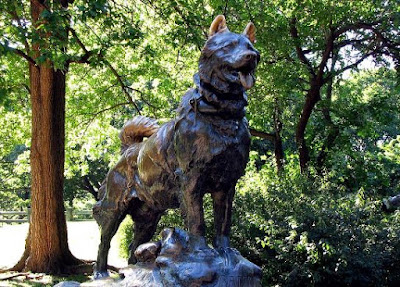Iwalkedaudiotours.com - Will Smith summarized it best in the 1993 movie “Six Degrees of Separation” when he commented that he was wondering, “Why was there a statue of a dog who saved lives in the Yukon in the middle of Central Park?” A question many have asked when passing the bronze sculpture of a sled dog named Balto.
 |
| Balto Statue |
An antitoxin was needed to save the small town of Nome and it would be needed quickly. The challenge lied in the fact in Nome’s relative isolation and lack of accessibility. The only three airplanes in the state of Alaska at the time had all been stripped down for the winter and were inoperable. Meanwhile, the nearest railroad station in Nenana was over six hundred fifty miles away. The only option was for the serum to be delivered via rail from Anchorage to Nenana and then carried by sled dog the remainder of the six hundred seventy four miles to Nome.
A team of twenty mushers and one hundred fifty sled dogs were assembled and the team departed on January 27, 1925. Amongst the team members were a sled dog named Balto and a Norwegian-born musher named Gunnar Kaasen who would each play key roles in the journey. Balto, a Siberian husky, was named for a Norwegian explorer named Samuel Balto. It was Balto who would guide the team through the final twenty-hour and fifty-three mile leg of their journey in near whiteout conditions.
Kaasen’s contribution, although less publicized, is perhaps more remarkable when one considers the feat he achieved. In addition to enduring temperatures that dipped to -40 degrees Fahrenheit, he saved the journey when just twenty-one miles out from their destination he noted that the lead musher had fallen asleep. When a gust of wind surprised the team, it toppled the sled and the serum was thrown into the surrounding banks of snow. Fearing the worst, Kaasen frantically clawed through the snow with his bare hands and despite near blizzard conditions was able to find the serum. After this, he reloaded the sled and led his team the final stretch of the journey. The team arrived in Nome on February 2 at 5:30 a.m. The first thing Kaasen did to celebrate his journey was pull the ice splinters embedded within the sled dog’s feet.
The historic five and a half day journey from Nenana to Nome has become known as the “Great Race of Mercy.” Each year a race known as the Iditarod Trail Dog Race is held along this path to commemorate the occasion. The serum provided did halt the diphtheria outbreak and the epidemic was limited to only claiming five lives when the alternative could have been much worse.
For his part in the rescue, Balto became a mini-celebrity for a short period of time. His fame was short lived however, and he and his team of sled dog companions were sold to a vaudeville show owner in California. While visiting California, a Cleveland businessman and former prize fighter named George Kimble visited the dogs and was horrified to find they had been severely mistreated. He assisted in raising the $2,000 necessary to reacquire six of the dogs and they were moved to the Cleveland Zoo where they spent their remaining days. Balto would pass away at the age of fourteen in 1933.
Lost but not forgotten, the city of Cleveland ensured that families would always have the opportunity to visit Balto. A taxidermist mounted the sled dog for display where he would be placed within the Cleveland Museum of Natural History where he remains to this day. Balto did make one final trek back to Alaska in 1998. During this time the state passed a formal resolution titled HJR 62 – ‘Bring Back Balto.’ The resolution called for Balto to be permanently returned to the home where Balto became famous, however, a compromise was eventually made where his remains were loaned to the Anchorage Museum of History and Art for five months before returning to Cleveland.
As to Balto’s Central Park tribute, it began via a collection of private contributions in 1925 by folks that were infatuated with his highly publicized tale. Although he had no association to New York City, the necessary funds were raised and a statue erected on December 17, 1925. The bronze sculpture which sits atop a rocky ledge features an enthusiastic canine with ears perked up to attention. Amongst the attendees at the statue’s unveiling included both Balto and musher Gunnar Kaasen. Balto’s attendance at an unveiling of his own statue marked only the second time this had occurred since 1871 when Samuel Morse similarly attended his own dedication.
The popular Balto sculpture was created by a Brooklyn-based artist named Frederick George Roth. Roth was already well known for his animal sculptures at the time of the Balto commission. His works were further well recognized throughout Central Park, with Roth having served as the head sculptor for the New York City Department of Parks and Recreation for a period of time.
Balto’s tale has most recently been retold via the 1995 animated film affectionately titled, Balto. The animated feature, featuring Kevin Bacon as the voice of Balto, was successful enough to lead to two sequels that were subsequently released in 2002 and 2004.
The Balto sculpture is located within New York City’s Central Park approximately one block inward from the East 67th Street park entrance.
- Website: http://www.centralpark.com/guide/attractions/balto.html
- Address: Central Park, New York City, NY (East Drive at 67th Street)
- Cost: Free
